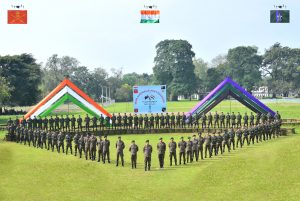Rajnath Singh’s recently concluded two-day visit to Australia — the first by an Indian defense minister in 12 years — marks a significant milestone in bilateral relations. Apart from signing three key agreements on information sharing, submarine search and rescue cooperation, and establishment of joint staff talks, Singh also participated in the Australia-India Defense Industry Roundtable held in Sydney to strengthen bilateral defense industrial collaboration.
Parallel to the visit, Australia’s first Defense Trade Mission visited Chennai and New Delhi to foster collaborations between Australian and Indian C5ISR (Command, Control, Communications, Computers, Cyber-Defense, Intelligence, Surveillance and Reconnaissance) firms.
The agreements signed are a culmination of the steady progress in bilateral defense and security ties since both sides upgraded their partnership to a Comprehensive Strategic Partnership in 2020. Singh’s visit takes off from discussions held during previous high-level engagements, including the visit of India’s Chief of Defense Staff Anil Chauhan to Australia in March this year, followed by Australia’s Deputy Prime Minister and Defense Minister Richard Marles’ visit to New Delhi in June. These discussions laid the groundwork for operationalizing key areas of cooperation during Singh’s recent visit — interoperability, reciprocal information sharing, joint deployments, and defense industry collaboration.
With the agreements now in place and existing arrangements such as the Mutual Logistics Support Arrangement, New Delhi and Canberra are well-placed to ensure that interoperability is maximized. This, in turn, paves the way for greater mutually reinforcing, purposeful, and coordinated presence across the maritime, land, and air domains, in areas of mutual interest, such as the Indian Ocean region. The two sides have taken a decisive step toward converting ambition to strengthen bilateral relations into action.
Notably, India has offered to maintain and repair ships of the Royal Australian Navy in Indian shipyards during deployment in the Indian Ocean, which will allow Australia to play a larger security role in the region. Australia, in turn, has extended an invitation to India to participate in future iterations of Operation Render Safe, which is an Australian Defense Force (ADF)-led operation supporting Pacific nations to safely dispose of remnants of World War II explosives in the region. Together with the proposed Joint Maritime Security Collaboration Roadmap identified in the joint statement, this creates an opportunity for both countries to adopt a truly strategic and integrated approach to maritime security in the Indo-Pacific, leveraging their strengths within their immediate maritime surroundings across the broader maritime region.
Singh’s visit carries significant symbolic weight, which must not be overlooked. New Delhi’s receptiveness to the Quad — comprising Australia, India, Japan, and the U.S. — has been seen by its partners as a litmus test of its willingness to deepen ties with Australia. At a time when India-U.S. relations are turbulent and there is growing uncertainty over Washington’s sustained interest in the Quad and its implications for the grouping’s future, Singh’s visit — which came a little over a month after Prime Minister Narendra Modi visited Japan — demonstrates that New Delhi remains committed to its partnerships in the Indo-Pacific.
At the same time, both New Delhi and Canberra have been careful to signal that the Quad remains important. The joint statement, without mentioning Quad explicitly, recognized “ongoing progress in defense cooperation among Australia, India, Japan and the United States,” and expressed support for “initiatives that advance closer maritime surveillance cooperation among the four partners.” Inviting Australia and Japan as observers to the India-U.S. bilateral Air Exercise Cope India in 2025 sends a strong signal that — in the words of India’s External Affairs Minister S Jaishankar — the grouping is indeed “alive and well.” This affirms New Delhi’s vision that the Quad complements, rather than replaces, India’s bilateral relationships in the region.
The outcome of Singh’s visit will go a long way in challenging perceptions in New Delhi, which sees relations with Australia as a subset of its approach toward Washington. For New Delhi, closer ties with Australia affirm that it has truly overcome the hesitations of history and now recognizes Australia’s regional and international salience. For Canberra, this was an opportunity to signal to the world that Australia has strong partnerships, beyond its alliance with Washington. Slowly, but steadily, New Delhi and Canberra ties have developed their own independent dynamic and the relationship is more self-sustaining now.
Looking into the future, India and Australia will need to carry forward the momentum in the bilateral relationship through sustained strategic engagement. Such engagement should explore opportunities for cooperation in third countries that advance the shared vision for Maritime Cooperation in the Indo-Pacific unveiled back in 2020. A plan of action outlining concrete steps that both countries will take to support the vision, supported by annual progress reports undertaken at the senior official level, will help ensure the sustained momentum.





























